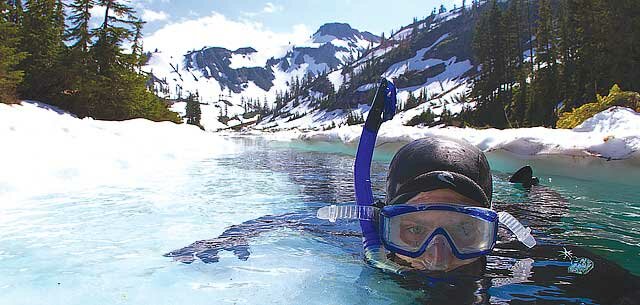 |
Polar plungeSnow snorkeling in Alpine Lakes By Patrick Kennedy Backpacking used to be something I looked forward to every spring, but that was life on the east side of the Cascade Mountain range. Don’t get me wrong – backpacking on the west side of the Cascades is comparable to what you would get in the European Alps. However, the best trails don’t reliably melt out until September with the 400 inches of snow the North Cascades have received the past two winters.
Living on the west side of the Cascades offers more outdoor recreation options than any place else I’ve experienced. In the spring, a dedicated outdoor adventurer can snowboard, mountain bike, kayak – and snow snorkel – all in the same day. Perhaps the name snow snorkeling isn’t quite refined enough; technically the snow has partially melted. However, snorkeling in an alpine lake with some of our deep snowpack afloat is visually an experience similar to what I imagine exploring the moon would be like. The environment is certainly fascinating. Alpine lakes are as clean and clear as they are cold. Sliding from a snow bank into a blue, green and white frigid, weightless environment defies all logic, even when wearing a quality wetsuit. Your body screams, “This isn’t right!” However, once the diving mask hits water a foreign, exotic world fights with your survival instinct to get out now. “Trust the suit. Trust the suit,” is the mantra repeated over and over in my head for the first few minutes in the water until fascination gradually replaces shock. Slowly, you forget about the stinging cold on exposed portions of your face, the only body part without life-saving, 5mm-thick neoprene. Visibility looking down seems endless, but the lake bottom isn’t the fascinating part. Once you’re acclimated, icebergs beg for exploration. Snow is far more interesting when suspended in a crystal clear aqua green layer. The bergs seem far too large to float, yet poking around them enables discovering the stable ones.
The Mt. Baker area has numerous alpine lakes suitable for snow snorkeling. Highway 542 offers easy access to Bagley Lakes, or time it right and hike into Lake Ann or Iceberg Lake. Twin Lakes is another prime area to explore, also likely to be accessible by late summer. Once the shoreline is mostly exposed and more than 50 percent of the lake is free of snowpack, the snorkeling becomes fun with a high-quality wetsuit, gloves and booties. Timing is critical. Once the bergs melt, snorkeling gets boring. Bergs create a surreal environment unlike anything else. Five hours can slip by as if it were only 30 minutes when snorkeling, body sledding and wrestling with icebergs are the day’s activity. Since discovering the joys of snow snorkeling I’m no longer a disgruntled backpacker wishing for the trails to melt out. Until they do, I add a wetsuit, booties, gloves, snorkel and mask to the Ten Essentials. X Patrick Kennedy recreates around water whether it be frozen, liquid or in transition. Visit him atpbase.com/patrickkennedy.
|